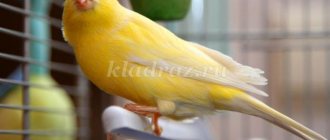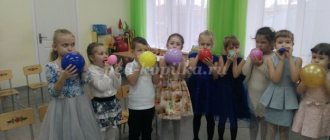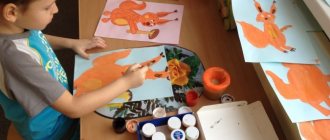GCD "Indoor plants" (middle group)
Well done! Guys, you already know that every plant has its own name. What names of indoor plants do you know? (Children name the plants and show them.)
2. Didactic game:
“Indoor and garden plants”
Educator:
Guys, what plants do you know besides indoor plants? (garden)
Can you tell them apart? On the table you see cards with pictures of indoor plants and garden flowers. They need to be distributed as follows: place indoor plants next to the flower pot, garden flowers - next to the flower bed.
3.Conversation about indoor plants:
Educator:
Children, look how many indoor plants there are in our group. What do you think these plants are for? (To make it beautiful.)
What else are indoor plants used for?
(Plants purify the air.)
It’s right that it should be beautiful—a person decorates his home with indoor plants. But they not only delight us with their beauty, but also cleanse the air of dust and dirt. Many indoor plants smell good.
Guys, what should you do to ensure that your indoor plant is always beautiful and doesn’t wilt? (care for a houseplant)
Let's tell you how we care for plants.
( children's answers)
4. Physical education:
Eat at home ( stand on your toes, stretch your arms up);
And there are bridges ( lean forward, arms back, knees straight
);
There are trees straighten up, ( round your arms above your head)
;
And the bushes, ( sit down, stretch your arms forward)
;
And to everyone’s surprise ( stand up, arms to the sides, body turns)
,
Plants in the room ( shoulders raised)
;
We can’t live without them ( hands on the belt, turning the head to the right and left)
;
Because we are friends! ( spread your arms to the sides, clasp your body with your arms
).
5. Game:
"What would happen if..."
-What would happen if the plant was placed in a dark place?
— What would happen if they forgot to water the plant?
— What would happen if you take care of the plant: water it, wash it, loosen the soil, feed it?
(Children's answers)
.
6.Planting a plant
Educator:
Let's plant geraniums with you. What does it take to plant a plant? (flower pot, soil, water for irrigation)
.
Children participate in planting the plant.
Educator:
Take a flower pot. What should we put in the pot first? (We fill the flower pot with soil and make a hole for the flower.)
After we've poured the soil, what's next?
(We plant the flower in the ground and sprinkle it.)
We have planted the plant, is there anything else that needs to be done? (Immediately after planting, the plant needs to be watered so that it grows better).
Reflection:
Complete the sentence: “I love taking care of indoor plants,
because..." (
children's answers)
Teacher:
Summary of educational activities for speech development in the middle group “Indoor plants”
Summary of direct educational activities in the middle group of kindergarten.
Author : Moiseeva Natalya Valentinovna, teacher of the State Budgetary Educational Institution Moscow Secondary School No. 1464 (preschool department. Indoor plants in kindergarten are not only a piece of furniture, but also a means of air purification, a means of “acquaintance” and communication between children and nature. We are so accustomed to flowers on the windowsill, that they have become part of our life, a life that is bright, green, fluffy and glossy, but always bringing joy. Goal : Remember the names of indoor plants, their parts and actions for caring for plants (watering, loosening the soil, wiping or spraying leaves Objectives: Educational . Instill interest in indoor plants, a desire to care for them. Cultivate a positive attitude towards nature, love of work, in order to get pleasure from work. Educational. Exercise children to speak in complete sentences, coordinating adjectives with nouns. Developmental. Develop aesthetic taste, the ability to receive positive emotions from the sight and contact with indoor plants. Develop the ability to describe an object, highlighting its parts and characteristic features. Materials Indoor flowers in pots, pictures of indoor plants, a cube with indoor plants depicted on its sides. Preliminary work. Daily care for indoor plants, observing them. Introducing indoor plants in previous sessions on the topic “Getting to know indoor plants.” Children become familiar with the names of plants, their parts, and techniques for caring for indoor plants. The course of the educational activity itself: (Children sit at the tables in their places). - Guys, would you like to go on a trip? (Children's answers) - Great, I also want to travel. We just need to think about where we should go? Tell me, where would you like to go on a trip and why? (Children's answers). -Wonderful, any trip is fraught with a lot of new and interesting things. When a person goes on a trip, he thinks, what interesting and memorable things will I see? Many of you have traveled: flown to different countries, traveled to big and small cities. Today, I I suggest you take a trip to the “City of Flowers”. Let's go? (Children line up in a circle). -Now, guys, close your eyes, and I will cast a magic spell that will help us find ourselves in the magical “City of Flowers.” (I read the spell, and at this time I put pots with indoor plants and pictures of indoor plants on the table. (You can turn on an audio recording of nature, birdsong). Spell.
In our group, on the window, on the green side, in painted pots, flowers have grown. Open your eyes and see a fairy tale. -Guys, open your eyes. Look how beautiful it is around. Tell me, what changes did you see? (Children's answers). - Absolutely right, we ended up in the magical “City of Flowers”, that’s why we have so many of them .Tell me, what names of indoor plants do you know? (Children's answers). -Well done, guys, you know a lot of names. Let's play with you.
Game with a cube:
Children stand in a circle. In turn, each child throws a cube and talks about that home the plant that falls out on the top edge of the cube. The teacher starts first and the children continue following his example. The name of the plant is said, what parts of the plant are, what is the height of the stem, what is the shape of the leaves, does it bloom, how to care for the plants and what benefits they bring to people. If a child finds it difficult to answer, we help him with leading questions. If the plant is flowering, the game develops in the other direction: for example, the violet has pink flowers. The teacher invites the children to look at the other children and say who has pink on their clothes. -Well done, guys, let's speak in complete sentences. Listen to me tell the story, and then you will tell it. I describe the clothes of a child who has pink on his clothes, then I invite several children to describe the clothes of other children. -Guys, we had fun playing, listened to stories about many indoor plants, but didn’t talk about how to care for them. Who can tell us about caring for indoor plants? Who has indoor plants at home and who cares for them? (Children's answers). - Well done, guys, they said everything correctly, that the flowers need to be watered, the soil needs to be loosened so that the roots can breathe, the leaves of some plants can be wiped or sprinkled. With our work we extend the life of the plants, they will grow for a long time and bloom beautifully, delighting us and our friends with his appearance. guys, tell me, when you look at indoor plants, does your mood lift, do you feel happy or sad? (Children's answers). - Of course, the sight of indoor plants lifts our spirits, and plants also bring benefits to people: for example, aloe juice can treat wounds and burns, and the juice can be dropped into the nose and there will be no runny nose. But children cannot treat themselves, this is a must Only parents do it, the plant allows treatment only to an adult. You don’t know how yet and can damage the plant, causing it to dry out. Therefore, just tell your parents about the beneficial properties of aloe so that they also know. Well done today, the trip was a success, but you and I need to return to the group. (Children line up in a circle, close their eyes, read a spell, open our eyes and children sit down). - Guys, we have returned from a trip, and so that we have a memory of it, I suggest you draw the indoor plants that you liked best. (Children draw indoor plants to the music. Finally, we look at the drawings and guess whose drawing it is and what plant is depicted on it).
We recommend watching:
Summary of a lesson in the middle group on the works of Marshak Notes of the GCD in the middle group “Help the Cockerel” Summary of the GCD in the middle group on the topic: “Who lives in the little house?” Summary of a design lesson in the middle group "Tumbler"
Similar articles:
Math lesson “Rectangle” in the middle group of kindergarten
MAGAZINE Preschooler.RF
Summary of a lesson in the middle group on familiarization with nature “The World of Indoor Plants.”Authors:
- Botkova Larisa Aleksandrovna, teacher of the highest qualification category
- Petrova Olesya Aleksandrovna, teacher of the 1st qualification category
- Rudneva Olga Nikolaevna, teacher of the 1st qualification category
MBDOU kindergarten 40 Kiselevsk, Kemerovo region
Educational field: “Cognitive development”
Integration of areas: “Social and communicative development” , “Speech development” .
Goal: expanding children's understanding of indoor plants, their benefits and structure.
Tasks:
- Expand children's knowledge about indoor plants, reinforce the idea that a plant is a living being. Introduce children to a new indoor plant - geranium, noting its characteristic features. Strengthen the ability to recognize familiar plants, name their parts (root, stem, leaf, flower), using models.
- Replenish and activate children's vocabulary based on in-depth knowledge. Expand vocabulary: geranium, dry and wet soil, moisture.
- Foster interest in research activities; teach you to think and draw conclusions. Encourage the desire to care for indoor plants, treat them with love and tenderness.
Progress:
Educator.
Children enter the group, the teacher reads a poem:
Let's walk slowly through the garden And say hello to every flower. I have to bend over the flowers, not to pick or cut them,
And in order to see their kind faces and show them a kind face.
Guys, now we will remember what you talked about with Nina Petrovna at the last meeting...
Watch the video clip “Plants are our friends” .
Educator.
- Guys, what do you think, who cleans the air from dust and dirt in our group room?
Children's answer: indoor plants (Music plays and slide 1 appears on the screen - “A flower blooms” ).
Educator. Right! In a group, in a house, in living spaces, indoor plants purify the air.
-Why are these plants called indoor plants?
(Because they grow in rooms, living spaces.)
- Why do we need indoor plants?
(For beauty, they create coziness in our home. A person decorates his home with indoor plants).
Educator.
- Guys, you know, today I came into our group and saw this flower on the window. Who do you think could have given it to us? (children's answers)
— And Vesna gave it to our Teremok and asked us to take care of it and look after it. And then it will bring us a lot of joy. Guys, what time of year is it now? In spring, nature comes to life, and so do our indoor plants after their winter rest.
- Guys, do you know the name of this houseplant? (No.)
Educator. This indoor plant is called “Geranium” (Slide 2 – geranium), or pelargonium. It is also called “Crane Nose” because the column of the flower sometimes grows into a long “beak” , very similar to the beak of a crane. Now it will be easier for you to remember the name of this plant. Let's take a closer look at it. What does geranium have? (Slide 3. “Structure of geranium” )
Children's answers: root, leaves, stem, flowers (if the plant blooms).
Educator (summarizes the children’s answers) - That’s right, geraniums have a stem, leaves, and roots (flowers).
Educator. What shape are geranium leaves? What color are the leaves? (Children's answers).
Teacher (summarizes the children’s answers). – Geranium leaves are round in shape, bright green in color, the leaf can also have a brown circle at the edge or with a white border.
-What color are geranium flowers? (Children's answers).
Educator:
– Geranium flowers can be of different colors: white, pink, red, crimson. Flowers are collected in inflorescences, like umbrellas. (Slide 4)
Educator:
– Where are the roots of geranium? Why do you think a plant needs roots? (Children's answers).
Teacher (summarizes the children’s answers)
-The roots of the plant are in the ground. Due to the root, the plant does not fall and stays firmly in the ground. The root also feeds the plant. When we water the soil in a pot, the root absorbs water, and it rises up the stem to the leaves and flowers (Accompany the story with a demonstration). To prevent the plant from withering, it needs to be watered.
- So we met a new plant.
Educator:
– Guys, tell me what you remember about geranium. (Children's answers).
— Guys, tell me, where are the indoor plants in our group?
In a corner of nature.
Educator:
-Let's introduce geranium to our plants in a corner of nature. In the meantime, our flowers greet each other, I invite you to the “Flowers” .
I ask you, flower: Pick up your leaf, go out onto the path, and stamp your foot.
Shake your head and greet the sun in the morning. Tilt the stem slightly - Here is a charger for the flower.
Now wash yourself with dew, shake yourself off and calm down. Finally, everyone is ready to celebrate the Day in all its glory.
(Children perform movements in accordance with the text).
Educator:
– I invite the children to go to a corner of nature.
— Guys, look, our geranium has already made friends with plants in this corner of nature.
— What indoor plants are found in our corner of nature? (violet, balsam, aloe, pike tail...). Children talk about plants.
Educator.
-Guys, what does each plant have (root, stem, leaves)
— How do you think plants differ from each other? (shape of leaves, size, some have flowers, others don’t).
- Well done! And now we will play the game “Flower Structure” .
(The teacher gives the children cards with images of a root, stem, leaves, flower). Children take turns laying out cards on a flannelgraph and naming a part of the plant.
- Guys, try to guess my riddle:
“There are no arms, no legs, but it moves. There is no nose, but he breathes. There is no mouth, but he drinks and eats.” (Plant)
- That's right, it's a plant! How does a plant move since it has no legs? (grows, turns towards the light)
— How does a plant breathe? (through leaves, roots)
— How does the plant feed? Just like us? (roots)
— That’s right guys, it’s the roots that feed the plant.
—Where is the food for the plant stored? (in the ground, soil)
— Plants’ nutrition is contained in the soil in which they grow. And if you pull a plant out of the ground and leave it like that, it will die.
— Plants move, breathe, eat. This means that we can say about them that they are living beings just like you and me.
Educator:
— Now we are going to play the game “What do plants need to grow? ” (Slide 5).
- Let's choose from these drawings - diagrams only what is needed for the life of our plants.
-Watering can! That's right, we water the plants with a watering can.
- Sun! Without sunlight and heat, plants do not grow.
— Plants need earth, air, water. In order for plants to be beautiful, grow and bloom well, they need to be fed with special fertilizers. And they definitely need good care, our care and love. And they will thank us with clean air.
— We will talk about how to properly care for plants in the next lesson. And now I invite you to once again admire the plants in our corner of nature.
| Next > |







